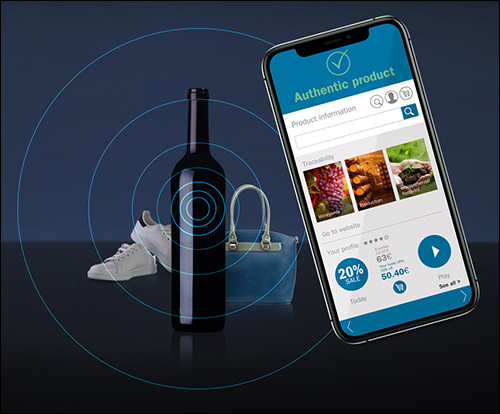Swiss semiconductor company EM Microelectronic has developed a new version of the em|echo, its hybrid Near Field Communication (NFC) and ultrahigh-frequency (UHF) RFID chip that combines Web-based content and product authentication via NFC tag reads for brand protection and user experience, along with UHF-based inventory management, on a single label. The dual-frequency chip is currently being deployed by the company’s partners, which include trusted-identities company HID Global, RFID label provider Smartrac and packaging company R-Pac, for retailer and brand end users.
The em|echo-V is a dual-frequency chip providing what EM calls RAINFC technology since it combines UHF RFID (RAIN) for supply chain management with an NFC interface for smartphone-enabled consumer-engagement and brand-protection applications. With NFC Type-5, which is compliant with the ISO 15693 standard rather than the more traditional ISO 14443 standard, the chip can provide Web authentication before, during or after a purchase, in order to enable consumer engagement. Companies can embed the chip in a label or a sticker tag, or they can integrate it into product packaging. Its memory can be accessed via both NFC and UHF communication protocols. The chip supports up to 2 kilobits of user memory for storing a URL, an EPC number up to 480 bits in size and other types of user data.

The use of the latest NFC standard in the em|echo-V enables any NFC-reading phone to access websites and videos, as well as dynamic, pre-purchase or post-purchase content related to a particular product, with the tap of a phone, explains Paul Muller, EM Microelectronic’s RFID business unit manager. A user can access the same information from the chip’s memory, whether reading the tag with a UHF or NFC reader. EM Microelectronic develops and manufactures semiconductors for companies that include its parent company, The Swatch Group. Its ICs include RFID-based products, as well as LCD drivers and displays, Bluetooth Low Energy (BLE) chips and modules, sensor ICs and power-management products.
EM has offered a family of dual-frequency chips that combine NFC and UHF RFID on a single chip, for the past four years. A UHF transmission is used for longer-range reading of a tag’s unique ID via a UHF RFID reader (about 10 meters [33 feet], for instance), while the NFC transmission brings read capability to the consumer at close range, by transmitting data to an interrogator built into the majority of smartphones currently available.
EM Microelectronic’s customers are interested in RFID to improve supply chain operational efficiencies, Muller says. However, he notes, there are other challenges that NFC is better designed to address—preventing counterfeiting, for example. The hybrid echo chip is already being used by brands to track and authenticate high-end products using a unique static ID or URL in combination with Android-based access technology. “The em|echo-V provides a smartphone platform-agnostic Web-authentication solution based on a dynamic NDEF message approach,” Muller states. The chip’s AES-128 cryptographic hardware implementation, designed to use minimum silicon space, enables a compact antenna designs thanks to its low power consumption and ISO 15693 air interface, he adds.
The em|echo-V offers another level of functionality, as it enables the accessing of Web-based authentication and product content. The company calls it a holistic omnichannel experience, which enables consumers to interact with a product throughout its life cycle, including long after it is purchased. “What we are presenting today is a major evolution” Muller says. The new product offers greater functionality and benefits for both brands and consumers, he explains.
For brands and retailers, Muller reports, the em|echo-V helps to fight the black and gray markets, for instance, by creating a record of a tag’s read history in a cloud or blockchain platform, whether reading is accomplished via a UHF or NFC reader. This, for instance, allows retailers to better ensure they aren’t receiving fake merchandise in the form of returns.
In addition, shoppers could read the tag using an NFC-reading iOS- or Android-based device to validate that a product was authentic before buying it. When a customer took a product home, he or she could continue to engage with that item’s tag, thereby gaining more content, such as how to re-order, make other purchases or use the product. The tag works with all standard UHF RFID readers, so companies with existing RFID readers in their stores or supply chain can deploy the labels within their existing reader infrastructure. With the shared memory, they can also use the UHF reader to read NFC-based data, such as how and when consumers interact with the product.
“The chip knows how many engagement points it has had per day for each individual item,” Muller states. By capturing that data, a store can gain analytics such as how well a product is attracting attention and act upon pricing and store layout. Consumer engagement information can be combined with RFID data, such as a product’s location in a store, if fixed readers are in use collecting location data. By combining the two sets of data, users can create an in-store heat map and thereby derive how to generate better traffic.
The new chip will also provide costs savings for inlay and label manufacturers, Muller says. It enables one-step chip assembly and one-step encoding or tag personalization, using already deployed hardware. A two-chip label for NFC and UHF RFID functionality would require twice that amount of processing, he notes, adding, “With a one-step approach enabled by RAINFC technology, personalization can be fast, efficient, cost-effective and consistent, as far as memory content.” And because the tag employs the NFC Type 5 standard, its size can be reduced, with improved sensitivity for a longer read range supporting smaller antenna form factors.

